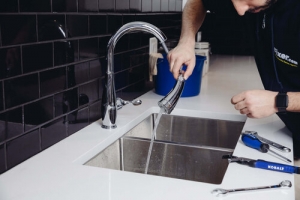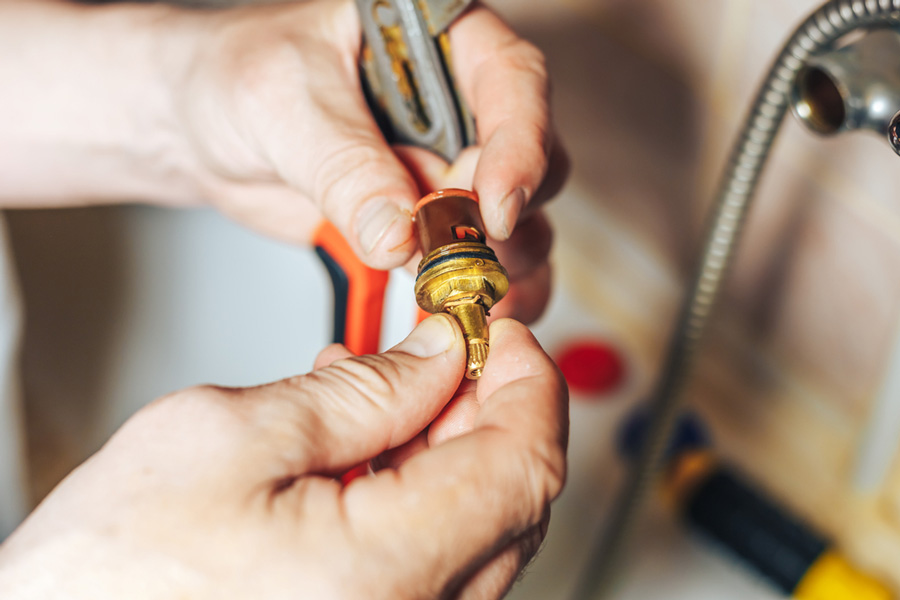What are your ideas regarding What Causes Leaky Faucets & How To Fix Them?

Leaking faucets may appear like a minor hassle, however their effect goes beyond just the nuisance of the noise. From wasting water to incurring unnecessary economic expenses and health and wellness risks, ignoring a trickling tap can bring about numerous effects. In this post, we'll delve into why it's crucial to resolve this common house problem promptly and successfully.
Wastage of Water
Ecological Influence
Dripping taps contribute substantially to water wastage. According to the Environmental Protection Agency (EPA), a solitary faucet leaking at one drip per secondly can waste more than 3,000 gallons of water annually. This not only pressures water sources but likewise impacts ecological communities and wildlife dependent on them.
Financial Expenses
Boosted Water Costs
Past the ecological effect, leaking taps can pump up water bills considerably. The gathered waste gradually converts right into greater utility expenditures, which might have been avoided with timely repairs.
Potential Property Damages
In addition, extended leaking can lead to harm to components and surfaces bordering the faucet. Water accumulation can trigger staining, deterioration, and even architectural issues if left unattended, resulting in added repair work expenses.
Wellness Issues
Mold And Mildew and Mildew Growth
The consistent presence of wetness from a trickling faucet produces an ideal environment for mold and mildew and mildew growth. These fungis not just compromise indoor air high quality however additionally posture health risks, particularly for people with respiratory conditions or allergic reactions.
Waterborne Diseases
Stagnant water in dripping faucets can become a breeding ground for bacteria and various other virus, raising the danger of waterborne conditions. Impurities such as Legionella germs flourish in stagnant water, possibly causing severe diseases when consumed or breathed in.
DIY vs. Specialist Repair service
Benefits and drawbacks of Do It Yourself Repair Work
While some might attempt to fix a leaking tap themselves, DIY fixings include their own collection of obstacles. Without appropriate knowledge and devices, DIY attempts can exacerbate the issue or cause insufficient repairs, extending the problem.
Benefits of Employing a Specialist Plumber
Hiring an expert plumber makes sure that the underlying source of the dripping faucet is attended to properly. Plumbings possess the know-how and tools to detect and fix faucet problems efficiently, saving time and minimizing the threat of more damage.
Step-by-Step Overview to Taking Care Of a Dripping Faucet
Tools Required
Before trying to take care of a dripping tap, gather the necessary devices, including a flexible wrench, screwdrivers, replacement components (such as washers or cartridges), and plumber's tape.
Usual Faucet Issues and Their Solutions
Recognize the type of tap and the particular problem creating the drip. Typical troubles include damaged washers, corroded shutoff seats, or malfunctioning O-rings. Describe maker directions or on the internet tutorials for detailed support on repairs.
Safety nets
Normal Upkeep Tips
To avoid dripping faucets, execute routine upkeep such as cleaning up aerators, examining for leaks, and changing worn-out parts quickly. In addition, think about installing water-saving gadgets or updating to a lot more efficient fixtures.
Importance of Prompt Repairs
Attending to trickling faucets as quickly as they're noticed avoids additional water wastage and potential damages, ultimately conserving both water and money in the long run.
Influence On Building Value
Understanding of Well-Maintained Property
Preserving a property in good condition, consisting of addressing maintenance issues like leaking faucets, improves its viewed worth and worth amongst possible customers or lessees.
Impact on Resale Worth
Properties with well-kept plumbing fixtures, including faucets, command higher resale values in the property market. Resolving leaking faucets can add to a favorable impact throughout home evaluations and settlements.
Environmental Duty
Individual Contribution to Preservation
Taking obligation for fixing leaking taps lines up with more comprehensive efforts toward water conservation and environmental sustainability. Every person's actions collectively make a substantial impact on preserving valuable sources.
Lasting Living Practices
By prioritizing timely fixings and adopting water-saving practices, individuals contribute to sustainable living techniques that benefit both present and future generations.
Conclusion
Addressing a trickling faucet exceeds simple convenience; it's an important action towards preserving water, reducing monetary expenses, and safeguarding health and wellness and residential or commercial property. Whether with DIY repair work or specialist help, doing something about it to deal with trickling taps is a tiny yet impactful way to promote accountable stewardship of resources and add to a much healthier, a lot more sustainable future.
How to Fix a Leaky Faucet: Step-by-Step Repair Guide
A leaky faucet may seem like a simple annoyance, but if it's not fixed promptly, that leak could cost hundreds to potentially thousands. From water damage to mold, mildew, and high water bills, even a tiny leak can be catastrophic if left unattended. Damage like this can even affect the overall value of your home, so it's important to take the right approach for leaky faucet repair. You may need the help of a plumber in some cases, but we've got a few tips you can try on how to fix a leaky faucet before calling the pros.
Four Faucet Types
When you're learning how to fix a leaky faucet, the first step is knowing what kind of faucet you're working with! There are four common types.
Cartridge Faucets
Cartridge faucets come in one- or two-handled varieties. In one-handled cartridge faucets, hot and cold water combines in a single cartridge. In the two-handled versions, hot and cold water are controlled separately and mixed in the faucet.
Ball Faucets
Ball faucets have a single lever you push up and down to adjust the pressure and rotate to change the temperature. A slotted metal ball controls the amount of water allowed into the spout.
Compression Washer Faucets
They're the oldest type of faucet, but they're still used in many homes — especially older ones. Compression faucets have two separate handles that, when turned, raise or lower the washer that seals a water valve. This valve stops water from flowing through the faucet when it is turned off.
Disc Faucets
Disc faucets rarely need to be repaired due to their maintenance-free design. The water flow is controlled by two discs — the upper one raises and lowers against a fixed lower disc, creating a watertight seal. If your disc faucet starts leaking, you may need to replace the seals or clean residue buildup from the inlets.
Fixing a Leaky Faucet
Step 1: Turn Off the Water
Whether you're learning how to fix a leaky bathtub faucet or how to fix a leaky kitchen faucet, always turn off the water supply to your working area when you're fixing a leak. The last thing you want is a flood added to your list of things to fix.
Look for the shutoff valves below your sink or around the tub and turn them clockwise to stop the water flow. If your faucet doesn't have shutoff valves, you may need to turn off the water for the whole house. Check to make sure it's off by turning the faucet on. If nothing comes out, you're ready to start the repair.
Step 2: Take Apart the Faucet
How you disassemble your faucet depends on the type of fixture you have. You can use a flathead screwdriver to remove the caps on top of the handle or handles for cartridge and compression faucets. Inside, you should see handle screws. Unscrew these with a screwdriver to remove the handle.
Disc- and ball-style faucets will typically have an inlet screw near the handle, and removing that will reveal the interior of the faucet.
Detach the Valve Stem
For cartridge- and compression-style faucets, you'll see the inner valve stem or cartridge once you remove the faucet handles. If you have a compression faucet, unscrew the brass valve stem. If you have a cartridge faucet, pull out the cartridge. If your cartridge has been in place for a while, it may require some tools or extra force to remove it due to mineral deposits.
Examine and Replace Parts
Once you've removed the parts, check them out to confirm what needs to be replaced. You may see corroded rubber washers, O-rings, stems, or cartridges. On a ball-style faucet, check the seats and springs for damage.
If you need to repair a leaky disc faucet, check the inlet and seals on the lower disc.
Once you determine what parts must be replaced, visit your local hardware store. Bring the damaged parts with you to ensure you can purchase the correct components to replace them.
Clean Valves and Faucet Cavity
If you've removed a stem or cartridge, you may notice mineral buildup in the faucet's threads. Use white vinegar to clean the valve seat by soaking it for a few minutes, then scrub it away with a soft toothbrush and rinse with warm water. You can also clean the interior of the faucet in the same way.
Reassemble the Faucet
Once your faucet is cleaned and the required parts have been replaced, it's time to reassemble it. Put the pieces back together and slowly turn the water supply back on. Doing this slowly is crucial because too much initial water pressure can damage the new hardware you've just installed.
https://homewarranty.firstam.com/blog/how-to-fix-leaky-faucet

I was made aware of that report about What Causes Leaky Faucets & How To Fix Them through a friend on our other web property. Sharing is caring. Helping people is fun. We treasure your readership.